Since both the groundnuts, and the jaggery(gur) are 1 kg in weight, the groundnuts are not more than the jaggery in weight.
NCERT Solutions For Class 3 Maths Chapter 8 - Who is Heavier
Who is Heavier deals with the concept of weight. This chapter have exercises on finding and comparing weights using nonstandard units, heavier, lighter, conservation of weights. The solutions for Math-Magic Chapter-8 have been created and verified by our experienced subject matter experts, according to the CBSE syllabus and guidelines of NCERT. For practice, our subject matter experts have created very interactive, activity-based, and Image-based worksheets on these topics to enhance learning.
Download PDF For NCERT Solutions for Maths Who is Heavier?
The NCERT Solutions For Class 3 Maths Chapter 8 - Who is Heavier are tailored to help the students master the concepts that are key to success in their classrooms. The solutions given in the PDF are developed by experts and correlate with the CBSE syllabus of 2025-2026. These solutions provide thorough explanations with a step-by-step approach to solving problems. Students can easily get a hold of the subject and learn the basics with a deeper understanding. Additionally, they can practice better, be confident, and perform well in their examinations with the support of this PDF.
Download PDF
Access Answers to NCERT Solutions For Class 3 Maths Chapter 8 - Who is Heavier
Students can access the NCERT Solutions For Class 3 Maths Chapter 8 - Who is Heavier. Curated by experts according to the CBSE syllabus for 2025–2026, these step-by-step solutions make Maths much easier to understand and learn for the students. These solutions can be used in practice by students to attain skills in solving problems, reinforce important learning objectives, and be well-prepared for tests.
Gur (jaggery) and Groundnuts
Are the groundnuts really more than the jaggery (gur) in weight or do they just look more?
Now guess, for which of these you need a bigger bag:
(1) 1 kg popcorn or 1 kg sugar?
(2) 1 kg peas or 1 kg potatoes?
Go to the market and check if your guess is right.
Do it by yourself as directed. Things which are bigger in size and lighter in weight will require bigger bags.
Pumpkin Tomato 'Panga'
How many small tomatoes do you think could lift the pumpkin up?
- Ten
- Twenty
- Forty
About 40 small tomatoes will be needed to lift the pumpkin up.
How many big mangoes can balance the pumpkin?
Answers may vary. About 20-25 big mangoes will be needed to lift the pumpkin up.
How many pumpkins can balance you on the see-saw?
Do it by yourself. An average pumpkin weighs around 2 kg.
Name some of your classmates who you think weigh
(a) Almost the same as you
(b) More than you
(c) Less than you
Do it by yourself..
How many books can you lift on one hand keeping your arm straight?
Do it by yourself. Answers may vary student to student.
Double her Weight
Now guess her weight and the amount of sweets her parents distribute every Independence Day.

The correct answer is:.
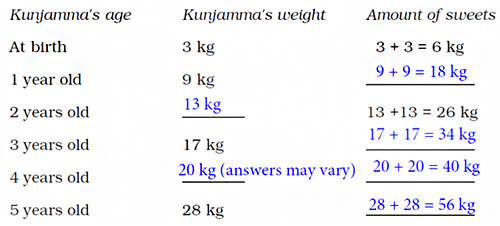
You can ask your parents how much a 2-year old or 4-year old child could weigh.
Do it by yourself. Answers may vary. A 2-year old child weighs around 11 kg -15 kg. A 4 - year old child weighs around 14 kg-19 kg
Yum-yum Rice
Help him match the things with their right amounts.
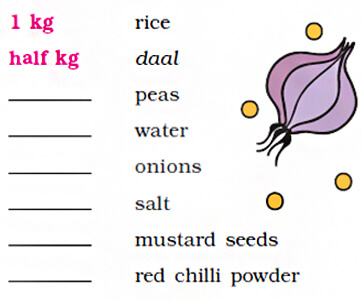
The correct answer is:
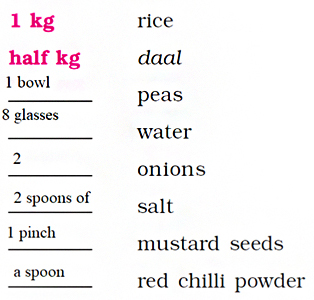
Activity Time
Make a list of things bought at your home. Find out how much of each thing is bought at one time.
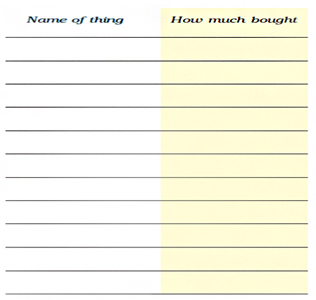
Do it by yourself. Answers may vary. Following is a sample answer.
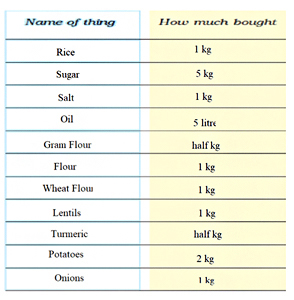
Guess their weights and match.
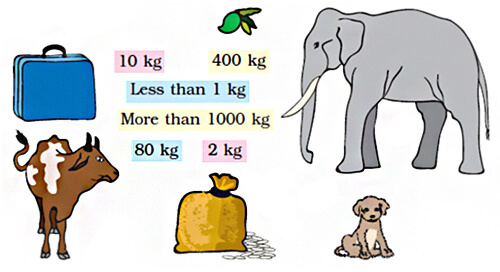
The correct answer is:
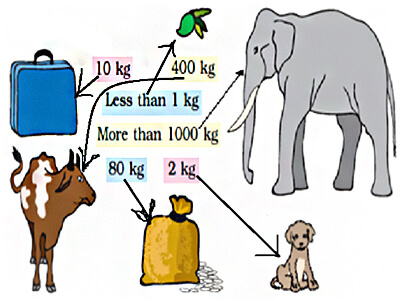
Bring a balance and a 1 kg weight to class. Check if your guess was right.
Do it by yourself.
Use your balance to find which of the following is heavier —
a) A water bottle or a cricket ball
b) Your shoe or your pencil box
c) Your Maths book or Hindi book
d) Your bag or your friend's bag
Answers may vary. A sample answer is:
a) A water bottle is heavier than a cricket ball.
b) A pencil box is heavier than a shoe.
c) A Math book is heavier than a Hindi book.
d) Your bag and your friend’s bag are almost equal in weight.
Weigh 1 kg of mud or sand. Divide it equally into 2 bags. Use the balance to check if both the bags have equal weight.
1 kg of mud and sand is equally divided into two bags. Both the bags weigh equal and the weight of each bag is half kg.
Make a list of
a) Things weighing less than half kg.
b) Things weighing more than half kg.
Do it by yourself. Answers may vary. A sample answer is:
| Weighing less than half kg | Weighing more than half kg |
| Empty water bottle | A pumpkin |
| Empty pencil box | A sack of rice |
| A bulb | A table |
| A Glass | A television |
| A Mango | A brick |
Guess which of the following things weigh more than 1 kilogram? Which ones will weigh less than 1 kilogram (kg)?
a) Your school bag
b) Geometry box
c) A brick
d) A big pumpkin
e) Your pair of slippers/shoes
Answers may vary.
| Objects | Weights |
|---|---|
| a) Your school bag | More than 1 kg |
| b) Geometry box | Less than 1 kg |
| c) A brick | More than 1 kg |
| d) A big pumpkin | More than 1 kg |
| e) Your pair of slippers/shoes | Less than 1 kg |
Look for Weights and Balances
Make a trip to your nearest junk dealer, vegetable shop and grocery shop. Have a look at the weights they use. Find out:
a) Who uses the biggest weight?
b) Who uses the smallest weight?
Do it by yourself. Answers may vary. A sample answer is:
a) The junk dealer uses the biggest weight.
b) The grocery shop and vegetable shop use the smallest weight.
In which shop would you find the following types of weights? Discuss with your friends.
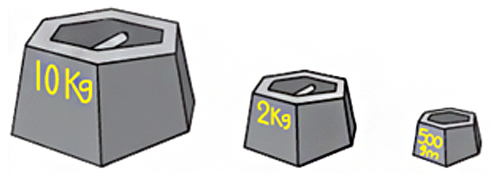
Do it by yourself. The shops which sell grains use these types of weights. Junk dealers also use these weights
Have you seen any of these balances?

Answer it by your experience. These balances are very commonly used in regular life. The gas cylinder delivery boy carries this balance with him for their customers.
In the grocery shop, the shopkeeper uses this balance.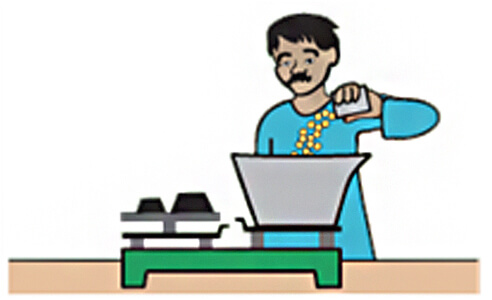
In the sweet shop, the shopkeeper uses this balance.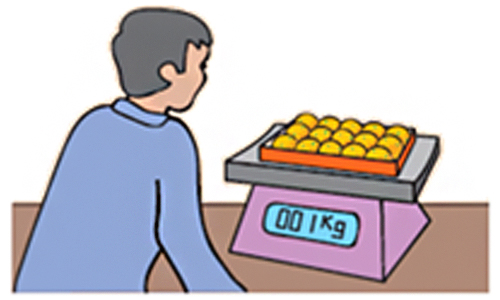
In the vegetable shop, the shopkeeper uses this balance.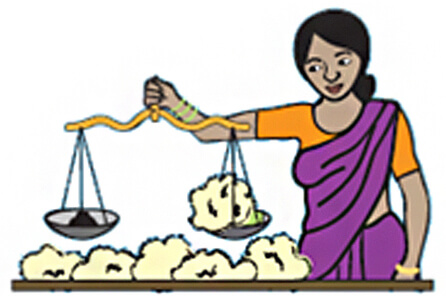
Admissions Open for
Admissions Open for
Frequently Asked Questions
The NCERT solution for Class 3 Chapter 8: Who Is Heavier is important as it provides a structured approach to learning, ensuring that students develop a strong understanding of foundational concepts early in their academic journey. By mastering these basics, students can build confidence and readiness for tackling more difficult concepts in their further education.
Yes, the NCERT solution for Class 3 Chapter 8: Who Is Heavier is quite useful for students in preparing for their exams. The solutions are simple, clear, and concise allowing students to understand them better. Where to Look Fromally, they can solve the practice questions and exercises that allow them to get exam-ready in no time.
You can get all the NCERT solutions for Class 3 Maths Chapter 8 from the official website of the Orchids International School. These solutions are tailored by subject matter experts and are very easy to understand.
Yes, students must practice all the questions provided in the NCERT solution for Class 3 Maths Chapter 8: Who Is Heavier as it will help them gain a comprehensive understanding of the concept, identify their weak areas, and strengthen their preparation.
Students can utilize the NCERT solution for Class 3 Maths Chapter 8 effectively by practicing the solutions regularly. Solve the exercises and practice questions given in the solution.
CBSE Schools In Popular Cities
- CBSE Schools in Bangalore
- CBSE Schools in Mumbai
- CBSE Schools in Pune
- CBSE Schools in Hyderabad
- CBSE Schools in Chennai
- CBSE Schools in Gurgaon
- CBSE Schools in Kolkata
- CBSE Schools in Indore
- CBSE Schools in Sonipat
- CBSE Schools in Delhi
- CBSE Schools in Rohtak
- CBSE Schools in Bhopal
- CBSE Schools in Aurangabad
- CBSE Schools in Jabalpur
- CBSE Schools in Jaipur
- CBSE Schools in Jodhpur
- CBSE Schools in Nagpur
- CBSE Schools in Ahmednagar
- CBSE School In Tumkur











